Movie Review – Boondock Saints, The
I remember the first time I saw it. You probably do to. That moment, when you watched The Boondock Saints and wondered how on Earth you’d missed it. It was probably recommended to you by a friend, somebody to whom a film such as this might appeal. Somebody with a slightly skewed cinematic radar, who appreciates all manner of film treats whether they be high art or complete trash. You probably only ever gave it a cursory glance at first, passing it off as a no-brand film that you’d never heard of, instead preferring to again watch The Matrix or Star Wars. But the hearty recommendation from your friend, plus the rather adult rating on the cover, indicated to you that it could, in fact, be a ton of bloody, violent fun.
– Summary –
Director : Troy Duffy
Cast : Sean Patrick Flanery, Norman Reedus, Billy Connolly, Willem Dafoe, David Della Rocco, Carlo Rota, Ron Jeremy
Year of Release : 1999
Length : 95 Minutes
Synopsis: Two brothers take on the Boston Mafia as vigilante’s, when the cops seem powerless to stop crime from becoming rampant.
Review : Awesomely cool debut flick from Duffy (who would make his next film, the sequel to this one, a decade later) with great characters, wonderful narrative technique, and more swearing than I’ve ever seen in any film, ever. Violent, morally slanted towards the ends justifying the means, The Boondock Saints is a thrill-ride of a film that only gets better with age.
*******************
I remember the first time I saw it. You probably do to. That moment, when you watched The Boondock Saints and wondered how on Earth you’d missed it. It was probably recommended to you by a friend, somebody to whom a film such as this might appeal. Somebody with a slightly skewed cinematic radar, who appreciates all manner of film treats whether they be high art or complete trash. You probably only ever gave it a cursory glance at first, passing it off as a no-brand film that you’d never heard of, instead preferring to again watch The Matrix or Star Wars. But the hearty recommendation from your friend, plus the rather adult rating on the cover, indicated to you that it could, in fact, be a ton of bloody, violent fun.
I remember my first time like it was yesterday. I had seen the cover of the VHS version of Boondock on the video shelf at the local rental joint, and scooped it up with a bunch of others to take home while on annual leave a few years back. I had never heard of it, but the back cover synopsis sounded pretty cool. More on that later. I sat down to watch it, not expecting a great deal, and was completely blown away. Not only was this the coolest film I’d ever seen (up until that point), but it resonated in a way I hadn’t seen in a film before. The violence, the themes, the comedy, the story: it’s as if somebody grabbed a swag of Tarantino’ leftovers, threw them into a blender, and hit puree. Blood, boobs and Latin vows, coupled with a highly camp Willem Dafoe, swanning through the film as the gayest police detective ever to show a badge, Boondock Saints, for me, revolutionized the way I looked at film.
There’s something indefinably cool about The Boondock Saints. Knowing a little about the back-story to the film only makes the end result even that much more impressive, a giant “screw you” to the corporate film-making mentality that subdues creativity and tramples individuality. Perhaps the drama and conflict behind the scenes added some spark to the on-screen performances, which is in itself a wild ride of guns, bullets and blood. Whatever the case, the end result is a cacophony of cool, slick, wonderfully filmed violence and vengeance, played out in large capital letters like a bizarre hyperactive child has been given the ability to direct a film.
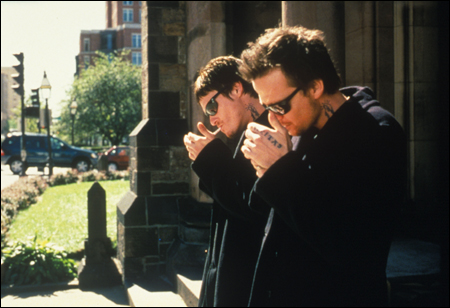
“There should be some of you in every city in America”
Sean Patrick Flanery (Young Indiana Jones Chronicles) and Norman Reedus (Blade 2) star as the Irish MacManus brothers, living and working in Boston, who become vigilantes after defending themselves from Russian Mafia thugs during a bar brawl while celebrating St Patricks Day. Together with their witless (hapless?) friend Rocco (David Della Rocco) they begin to take down the crime lords who run the city, in increasingly daring attacks. Of course, those crime lords don’t want to take this lying down, so they hire themselves El Duce, a paroled psychopath (Billy Connolly) who is perhaps the only person who can take the brothers down. In the middle of all this, mind you, are the police, led by FBI agent Paul Smecker (Willam Dafoe), who are seemingly powerless to stop the brothers from their holy charge, and conflicted as to whether they should in fact help the brothers out.
The Boondock Saints never pretends to be an intellectual study on the duality of vigilantism, nor is it an indictment on violence or the proliferation of weapons in the great USA. While the theme of vigilante justice in a society beset by violence and depravity is touched on throughout the script and the actions of the characters, The Boondock Saints never tries to offer up a definitive answer, electing instead to remain simply a piece of trashy entertainment purporting to be something more. The actions of the heroes, in which they decide to take no prisoners when they take down the Mafia figures through Boston, is portrayed as victorious, justified, even the brothers dialogue reflects that perhaps this battle cannot be won and they will no doubt meet their doom doing it. This somewhat depressing fate accompli is offset by a larrakin spirit, a derring-do mentality that permeates the majority of the film.
Director Duffy has been criticized a lot by geeks and film reviewers around the globe since Boondock was first released: his message, if you can call it “a message”, seems to have been lost or diluted by an overkill of style in place of substance. Glorious slo-motion, a penchant for giddy, frenetic camera moves and über-cool angles reminiscent of the Wachowski Brothers work on The Matrix (Boondock came out about about 6 months later than the first Matrix film) have mixed the message the film tries to impart with a slick, veneer-obscured Hollywood vehicle, and consequently, audiences didn’t get it.
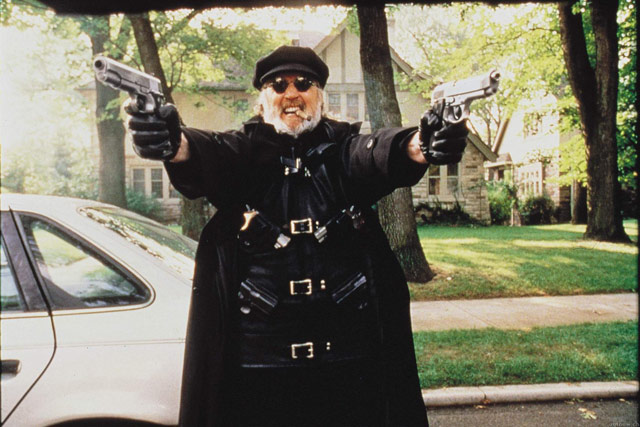
“What’s the Symbology?”
The Boondock Saints is nothing if not entertaining, especially if you’re an action fan. Director Duffy’s frenetic editing, Della Rocco’s hysterically overblown performance as hitman-wannabe Rocco, and a pulsating, intelligence-pummeling soundtrack, are the key ingredients to a self-indulgent mess; however, for the Saints, it works. Dafoe hams it up beautifully as the camp FBI agent Smecker, his leering, smarm-filled delivery a wonderful contrast to the more brutal, realistic moments featuring the MacManus brothers. His forensic dissection of a key crime scene at the beginning of the film is particularly delightful to watch, as he takes the local fuzz apart with his incredible deductive skills. The script is peppered with little asides, little snippets of a larger story within the smaller ones, quite a feat for first-time director/screenwriter Duffy. Each of the ancillary characters has just enough unique dialogue to develop themselves, but not too much as to detract from the main action. From the tourettes-afflicted barman (Gerard Parkes) of the local dive, to the permickity crime lord “Papa” Joe Yakavetta (Carlo Rota), each smaller role is honed to perfection with glances, sniggers, physical affectations; each adding to the hilarious whole that personifies the Boondock Saints.
And what action we have. Glorious shoot-outs, bar brawls, cross-dressing law enforcement officers and one of the meanest, most evil bad-guys ever put on the big screen: Il Duce. Billy Connolly plays his fiercest role yet as the silent, deadly (and perhaps psychotic) mass murderer,who is sent by the Mafia to kill the brothers. Nobody knows his real name, apparently, and according to a line of dialogue in the film, if you want your “problem” solved, he’s the absolute last resort to do it. Once you let him off the leash, nothing and nobody can stop him. Over-the-top, almost comic-book styled characters, akin to something from the mind of Frank Miller, much of Boondock Saints is given over to the hysterical camera-work Duffy provides, very singularly in the vein of Demian Lichtenstein or Joe Carnaghan. In a kind of homage to Tarantino, Duffy injects his bravura rapscallion ethos to the film, a script replete with more swearing per minute than any in recent memory, all to the effect of trying to make Boondock more cool than it should be. The characters are hyperbolic, the writing pure pulp, the acting all first rate for a film as silly as this.
Connor and Murphy MacManus live the dream of every civilized person alive who sees evil being committed, with little consequence. That is, they confront evil and destroy it, with little regard for the reality of man’s laws. An analogous reference to the modern societal issue of consequence and responsibility, Boondock appears on the surface to resemble little more than a ballet of guns and death; people should dig a little deeper. While Duffy’s external scripting belies the deeper, hidden meanings of Boondock Saints, people prepared to investigate the underlying morals, theological and philosophical, will find something more intelligent than most give the film credit for. In taking this vigilant action to destroy crime and the seedy underbelly of Boston, can the MacManus brothers lay claim to be doing Gods work? Indeed they seem faithful, a good Irish Catholic mindset putting them in good stead for the judgements they have ahead. However, far from the religious overtones that bookend the film, in which we’re given the treatise that for evil to triumph, good men need do nothing, The Boondock Saints tackles even heavier questions than simply what restrictions do we have as humans to take action. For instance, should we confront evil with it’s own kind: an eye for an eye, as it were. And to what ends should we, as a society, be able to tackle those who defy rules and normal human behavior. While the film deals primarily with the underground drug trade, the corruption and foetid stink of organized crime, the issues could certainly be extrapolated out to include everything from child molesters to rapists and serial killers. To what lengths should we go to to stop these people? According to the Boondock ethos, those who decide to take these people on at their own game by violent, bloody means, should by rights also be held to account for their actions. But society is a fickle mistress. Often we applaud those who desecrate evil, to the extent that we forgive the violent nature of the act. After all, the ends justifies the means, right? If you subscribe to vigilantism then yes, they do. Gunning down large quantities of Mafia heavies in a fire-fight is merely a cause for exultation at the fact more criminals are removed from our streets, according to Duffy: at least, he asks that of us, if not giving us the answer.
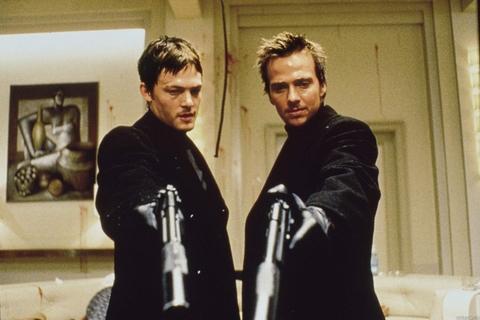
Remember that -shirt slogan from a few years back: “Kill ’em all, let God sort ’em out!”? This philosophy is externalised by Connor and Murphy when they decide to do Gods will (as they see it) in taking down crime. Regardless of accountability on the criminals side, they slaughter everyone associated with them for simply associating with them. Wanton destruction, indeed. The Saints, struggling with their own internal moral code and sense of right and wrong, decide that the current system of control (police, lawmakers and criminal justice systems) have failed mankind, and decide to ascend to a higher authority: Gods. While God never comes right out and says “please kill all gangsters, child molesters and murderers” at any stage of the Bible, the MacManus Brothers simply accede to His authority and His punishment for the betterment of mankind; a selfless act of piousness that will undoubtedly lead them to eternal damnation. By killing those who do wrong, they are in fact killing, a tenet deplored by God in one of his Ten Commandments: Thou Shalt Not Kill. Indeed, the brothers take this on willingly, defying the wrath of God for the well-being of us all.
“Where’s my cat?”
The brothers are highly intelligent, if somewhat recalcitrant, and while they manage to bluff their way through several shoot-outs and killings, they never come across as a third-rate bumbling outfit like, say, the Three Stooges. The “stooge” of the group is Rocco, the foolhardy friend who accompanies them on their spree to defeat evil, and it’s his persuasion that pushes Connor and Murphy to do what they do. Rocco is the “human” element, the Everyman of this bizarre scenario, even if we can’t identify with him because of his inordinately crass bluster and desire to do harm. The brothers have a scene in the police station with Agent Smecker, where they converse in various languages, an attempt by Duffy to infuse their moral compass with some sort of authoritative weight; after all, these guys are intelligent, so why would they do stuff so stupid and risk their freedom. Duffy chooses to make Smecker a little camp, if not outright Gay Queen (in one hilarious scene, Smecker dresses as a woman to infiltrate the Mafia headquarters!) but not stupid. In fact, Smecker is a match with the brothers themselves, at least on an intelligence level. I tend to think Duffy chose to make Smecker this way to clash with the blatant heterosexual chest thumping carried out by almost every other male character: Smecker essentially puts those he encounters at a level of unease. It’s this conflict on a character level that I find so interesting, and is a part of the film that perhaps doesn’t get it’s due in nearly any review of Boondock that I’ve read.
As mentioned earlier, there’s a sense of deeper, hidden meaning behind the copious violence and ballistic, operatic death handed out here. Many will find the violence and language in Boondock Saints off-putting. Indeed, I think the film will loose many viewers for this fact, and I can agree with those critics who state that the motivations and narrative thrust of the film tends to get lost in all the visual bluster. But if you’re able to accept that The Boondock Saints is firstly an entertainment, and secondly a moral lesson in one of Gods commandments, then you’ll most likely appreciate what you see. After all, this film is nothing if not hyperbole ramped up past eleven. It’s got a message to tell, but it doesn’t give up its secrets easily. In fact, people who view this film for the first time often don’t even realise they’re being preached to, instead they simply see the bullets and blood spraying across the screen. Only upon reflection, and even only during the end credits of the film, do they start to ask exactly what they themselves might do in similar situations.
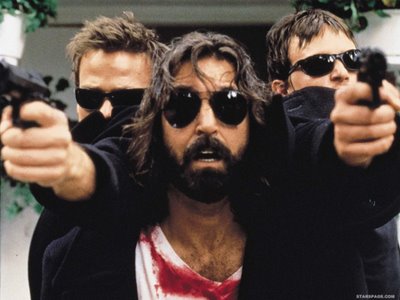
Flanery and Reedus provide us with charismatic, dynamic leading roles. Reedus looks slightly uncomfortable with the Irish accent, but Flanery hits every note spot on. Connolly, as mentioned before, is perfectly cast as the hardcore criminal Il Duce, and the storys shift in the third act to a more family-oriented opus is both surprising and enjoyable. Della Rocco is hilarious as the best friend, although his constant abuse of the English language can be a bit wearing at times, and his portrayal of the enthusiastic accomplice seems a little one-note throughout. Cameos by porn performers Ron Jeremy and Jeanna Fine add an element of the risque to proceedings, and Carlo Rota plays his Mafia Don role to slimy, masculine perfection. While the cast tend to get lost in amongst the many thing happening throughout this film, one thing remains certain; you don’t quite know how it’s all going to turn out.
Another thing to like about Boondock is it’s score and editing work. The soundtrack to this film is outstanding, as if Duffy channeled Tarantino when compiling a list of music he wanted included. From classical music, to trance and even music from the directors own band, this film has a touch of just about everything. While this may have turned the film into a nightmare in terms of musicality, Duffy makes it work a treat. The result is a pleasing soundtrack to listen to as the film progresses. On the editing side, the non-linear narrative Boondock utilizes allows for the mystery and sneaky unraveling of the plot to occur: editor Bill DeRonde must have thanked his lucky stars he got to work on this film. While non-linear edits can tend to confuse and audience when handled badly, in Boondock it works so well you hardly have to think of where certain scenes take place in the context of the film. Fabulous stuff.
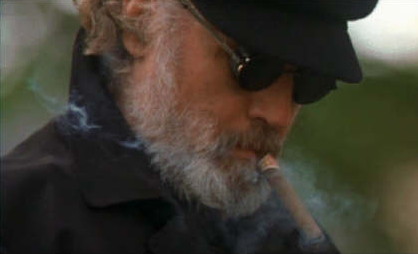
The background story to The Boondock Saints reads like a bad Hollywood script in itself, and if you investigate a little deeper, you’ll be surprised that the film ever made it to the screen at all. That said, the end result is one of cinematic symphonic masterpiece, a bizarre concoction of characters and techniques that, in any other film, would have been a complete catastrophe. The Boondock Saints defies it’s own ruin by being humorous, violent and aggressive, a blood-soaked diatribe to the iniquities of a rapidly decaying society and the prevalent nature of what can happen when good men decide to do something about it. Filled with iconic imagery, stand-out characters and some unique moments on film, The Boondock Saints is one hell of a cool film.

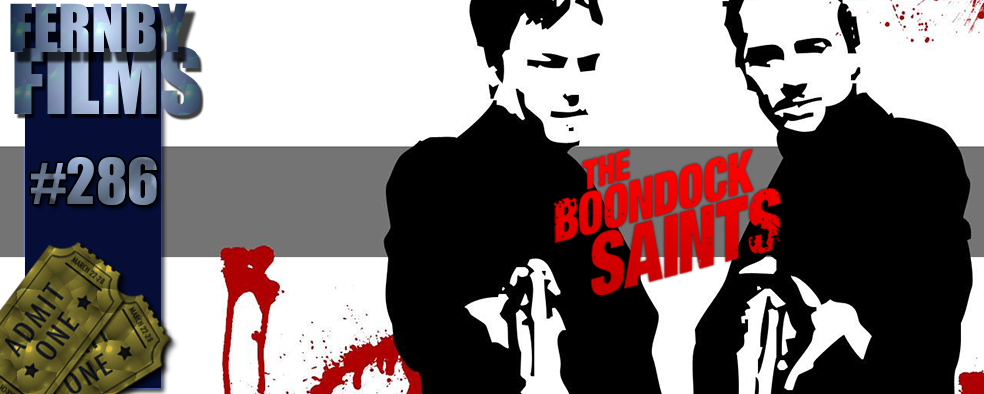



 The Boondock Saints (1999)
The Boondock Saints (1999)





I am looking forward to the 3rd movie. I can't believe how incredible these movies are. Thank you Troy Duffy and Boondock cast, you're amazing.
They are amazing, but I think they should just stop now.
This is my FAVORITE movie and nothing else since ive seen it can compare. The second one is just as good and if not better… PUMPED for a third one.
I don't think a 3rd one is really warranted.
love this f*cking movie so much that i can explode
Don't make a mess, Em.
I think one of the reasons Murphy's (Reedus) accent was slightly more diluted than Connor's (Flanery) is that, in the movie, Connor is portrayed as the more intelligent of the two (as seen in the air duct scene), while Murphy is the one who's a better fighter (as evidenced in the bar fight scene when Connor says to two of their friends, "No, he can take care of himself!"). Connor also seems to be happier to see their dad at the end. This, coupled with the fact that he's smarter, would explain why he has a truer brogue.
So Connor has a better version of the accent because he's smarter?
Best Movie Ever!!! Love it to pieces!
Me too!!!
An amazing film, truly. I was so irritated at myself when I finally got around to watching it that I hadn't seen it sooner. =)
I felt the same way, Gene. Truly a great little surprise-packet of a film.
this is the best f'n movie ever! the cat scene…epic! laughed my ass off for ten whole minutes! Gets better with each view!
Indeed, the more you watch it, the more you notice!!
this movie was awsome and the second one was just as good if not better looking forword to a number three
Have to say, I didn't like the 2nd one much. Thanks for dropping in!!
I LOVE this film. It's on my top 5 list of most awesome movies.
It IS all kinds of awesome.